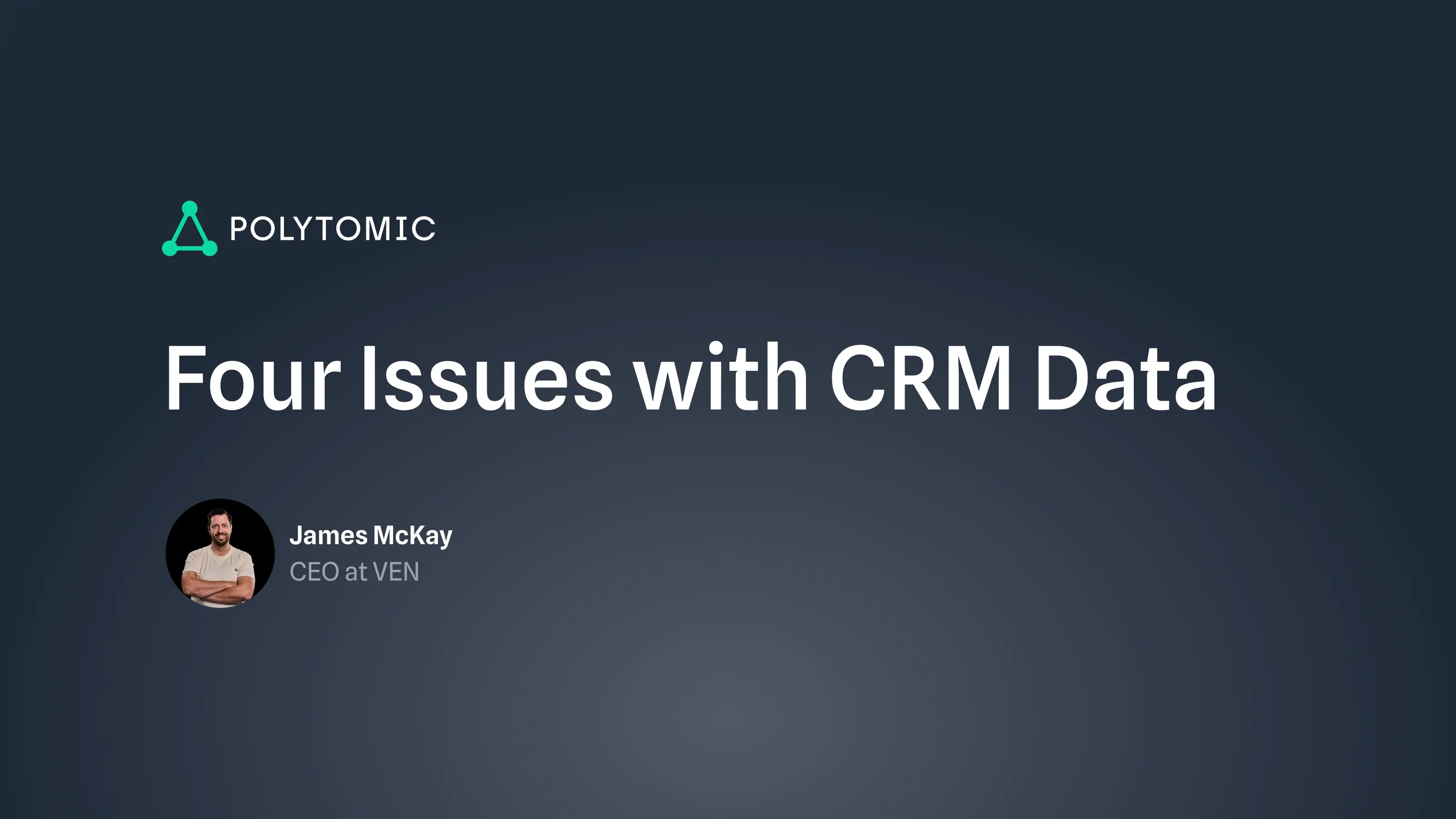
Four Issues with CRM Data
In this guest post, James McKay (CEO of VEN) describes the four most common issues in CRM data that he encounters with his clients.
CRM data.
Those who work with CRMs will likely cringe upon reading those words, and for good reason. CRMs are often the focal point of unpleasant conversations about poor data integrity. Whether poor data has entered the system, or good data has been made bad as it has been processed by your CRM, it always seems as if leaders in every organization are ready to utter the dreaded phrase: “I don’t trust this data”.
It’s a fair point. There are a number of unique reasons why CRMs are a hotbed of dirty or untrustworthy data. Let’s explore.
Issue 1: Non-Technical People vs. Highly Technical Tool
Collecting accurate clean data is always hard, especially when combining a non-technical user base with a highly technical tool. In the case of a GTM function, the following are almost always true:
- CRMs require significant manual human input.
- CRMs are highly technical.
- CRM users are typically not technical.
Untrustworthy data is a natural outcome when considering all of these factors. It falls upon revenue operations leaders to minimize the margin for error, thus ensuring user-entered data is accurate. This might involve simplifying user interfaces, enhancing user training, or implementing more intuitive data entry mechanisms.
Issue 2: Stage Confusion
Stages are the backbone of a CRM. All critical funnel metrics are built off them, from conversion rates to deal velocity. Yet, many organizations suffer from stages that are poorly defined or applied inconsistently, resulting in confusion that undermines the CRM's purpose.
To avoid these pitfalls, it’s crucial that GTM leaders anchor their CRM data with clear stage definitions, precise entry criteria, and explicit exit criteria. Here’s how to enhance clarity and coherence:
- Clear stage definitions: craft detailed descriptions for each stage, leaving no room for ambiguity. These definitions should reflect the unique journey of your customers and be easily understandable by all CRM users.
- Clear entry and exit criteria: establish and communicate the specific conditions that trigger the movement of a prospect or customer from one stage to the next. This clarity prevents subjective interpretations and ensures a uniform application across the board.
- Regular training and communication: conduct regular sessions to familiarize everyone with the stages and criteria. Use real-life scenarios to illustrate how and why a prospect moves through different stages, reinforcing the practical application of these concepts.
Without these measures, CRM users may default to their interpretations, leading to data inconsistencies that render reports unreliable and poor decision-making fraught with uncertainty.
Issue 3: Lack of Hygiene Rituals
Ideally, automation, training, and CRM design should address as many data hygiene issues as possible at the point of entry. Despite this, sometimes bad data makes it through. Stakeholders struggling with data integrity issues should prioritize incorporating regular hygiene practices into their routine.
Periodic rituals for maintaining data hygiene, though simple and effective, remain surprisingly rare. GTM leaders are encouraged to allocate a dedicated time slot—such as a half-hour each week—for their team to review and clean out old records. Beyond this, implementing a quarterly data audit can significantly improve data accuracy and usability. These audits involve a comprehensive review of the CRM's data for duplicates, inaccuracies, and obsolete information, ensuring that the database remains current and reliable.
Issue 4: Poor Planning and Manual Tracking
Ideally, every data tracking initiative would be planned considering time for CRM engineers to configure the system to capture corresponding data effectively. However, the reality is that GTM leaders often announce new initiatives without accounting for technical preparation. As a result, these initiatives often require tracking metrics that the CRM is not yet engineered to handle automatically. Consequently, spreadsheets often serve as makeshift databases for new metrics, opening the door to numerous issues. The manual entry and transfer of data are prone to human error, inconsistencies in data handling, and inefficiency.
The disconnect between the strategic vision of GTM leaders and the operational capabilities of CRM systems underscores the importance of aligning initiative planning with technical readiness. Without alignment, the risk of creating data silos, fostering mistrust in the CRM data, and ultimately compromising decision-making processes increases.
Better communication between GTM leaders and technical teams responsible for CRM management ensures that new initiatives run smoothly and efficiently, preserving the integrity of CRM data and ensuring clean reporting.
